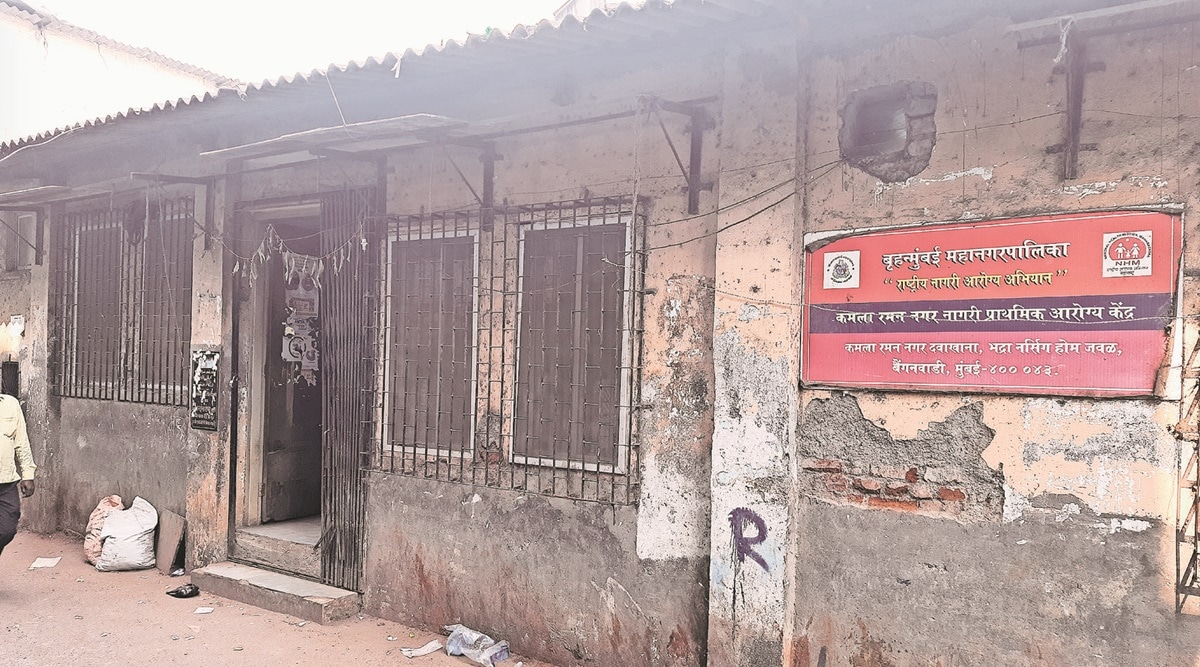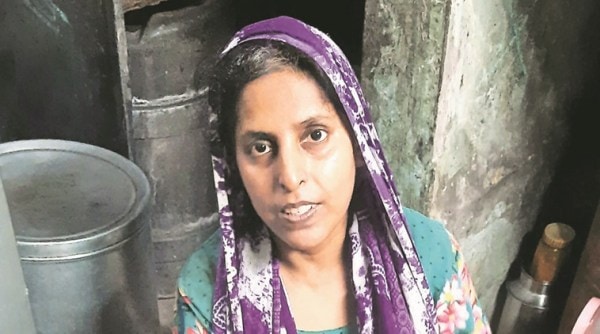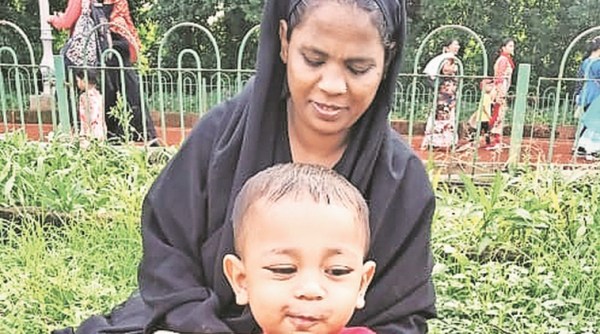 An outside view of a health post in Shivajinagar, M-East ward (above); and (right) women line up inside a centre to get their medicines. (Express Photo by Rupsa Chakraborty)
An outside view of a health post in Shivajinagar, M-East ward (above); and (right) women line up inside a centre to get their medicines. (Express Photo by Rupsa Chakraborty) Until last year, Khushboo Khan was like any other school-going teenager – carefree, joyful and surrounded by friends. But everything changed in July, when her mother died of excessive blood loss while delivering a child.
Khan, now 17, her school days behind her, spends all her time tending to her infant brother in a 100-sq-ft, dank, flimsy hutment, which is her residence in Shivaji Nagar, Mankhurd, in M-East ward.
The trauma faced by the Khan family is, however, not a one-off case. While there has been a major reduction in maternal mortality worldwide, M-East ward remains one of the few areas in Mumbai that have gone against the grain, having one of the highest maternal mortality rates compared to other parts of the state capital.
Data accessed by The Indian Express through a Right to Information (RTI) application shows that between 2016 and 2021 (September), of 8,32,310 deliveries recorded in Mumbai, 709 resulted in women dying during childbirth or six weeks after delivery. With 97 casualties, M-East ward recorded the highest number of deaths among all 24 wards in Mumbai. The ward, which houses roughly 6.5 per cent of Mumbai’s total population, has contributed 13.68 per cent to the city’s total maternal deaths in the last six years.
The M-East ward includes the areas of Govandi, Deonar, Mankhurd, Shivaji Nagar, Cheetah Camp, and a part of Chembur, with nearly 80 per cent of the population living in slums. It has Asia’s second largest and oldest open landfill that continues to receive around 4500 metric tonnes of garbage every day.
In 2016, the ward recorded 25 maternal deaths out of 6,858 deliveries. In 2017, the number dropped to 17 among the 7,422 deliveries. In the following years, the fatality dropped further to 14 and 13 in 2018 and 2019 out of the 7,014 and 7,118 respectively deliveries in the ward. However, in 2020, even as the number of deliveries dropped to 4,963 in the backdrop of the Covid-19 pandemic, the maternal death figure rose to 15. Last year, till September 2021, the ward had 4,679 deliveries, 13 of which resulted in the death of the women.
 Nasreen Zilani Ansari died at child birth last year in April and September respectively
Nasreen Zilani Ansari died at child birth last year in April and September respectively An analysis of the RTI data shows that wards with higher number of deliveries than M-East ward have recorded lower maternal deaths. The K-West ward, which covers Andheri West, had 67,697 deliveries in the same period—the highest among 24 wards — but reported only 28 maternal deaths. The F-South ward comprising Parel areas has recorded only six maternal deaths out of 65,162 deliveries. The F-North ward (Matunga) recorded 57 deaths out of 61,860 deliveries. Thirty one maternal deaths were registered in N ward (Ghatkopar East) where 60,769 deliveries had been carried out in the same period.
A closer look at the healthcare facilities reveals exactly why other areas have fared better than M-East.
The K-West ward has one of the best health infrastructure in the city with a tertiary care hospital—RN Cooper Hospital, 10 municipal dispensaries and as many health posts. This is besides two major private hospitals— Nanavati and Kokilaben hospitals — along with 105 private nursing homes.
“Due to timely interventions and presence of experienced specialists, we have been able to save many pregnant women with severe health complications,” said Dr Shailesh Mohite, dean of Cooper Hospital.
The F-South ward, which recorded the lowest number of maternal deaths in the period, has the biggest civic-run tertiary-care hospital, KEM hospital, and Wadia maternity hospital with efficient gynaecology departments.
Suresh Kakani, additional commissioner, Brihanmumbai Municipal Corporation (BMC) said that the number of maternal deaths have gradually decreased in M-East ward. But when asked about the surge in deaths amid the pandemic, he said, “Each maternal death is investigated individually and the report is submitted to the Centre. We will look into it.”
 Manawar Jahan Khan died at child birth last year in September.
Manawar Jahan Khan died at child birth last year in September. Poor Health Facilities
Social welfare experts attribute the skewed maternal health indicator in M-East to inadequate healthcare facilities. The health facilities in the ward are far behind the guidelines of Urban Development Plans Formulation Implementation (UDPFI). Despite being the fourth most populated ward in Mumbai that houses over eight lakh people, the Tata Institute of Social Sciences (TISS) found out that population per hospital is 27,438, compared to the Mumbai’s average of 9,696.
“We all talk about Dharavi (the biggest slum in Asia) but don’t focus on M-East with the worst health condition among the 24 wards. For years, BMC, the richest corporation in India, has been ignoring this ward,” said Dr Amita Bhide, Dean and Professor in the School of Habitat Studies, TISS, Mumbai.
Maternal mortality is considered a key health indicator. It has been observed that newborns whose mothers died from maternal causes often face nutrition deficiencies. “Studies have shown that they are less likely to have access to adequate health care, which affects their overall upbringing,” said Dr Mukesh Agarwal, head of paediatrics at KEM hospital.
“Older children drop out of school to care for younger siblings and contribute to household and farm labour which may be beyond their capacity and age, and often choose migration in search of better opportunities,” reads a report published in the Reproductive Health journal.
A large chunk of the wards population is migrants who have been forced to live in squalid conditions. The average house size is 150 sq ft and the area is considered as a hotspot for Tuberculosis, dengue and malaria among others. Maternal health, though, is what bears the maximum brunt of the condition in the area.
The M-East ward, which caters to 8,07,720 people, as per Census 2011, has only one secondary level hospital— Shatabdi Hospital, Govandi. The nearest tertiary care, Lokmanya Tilak General Hospital, also known as Sion Hospital is around 9 kms away. It costs Rs200 to travel in a taxi or auto to reach the hospital in an emergency – quite a huge sum for citizens whose per capita income per month is Rs 3,400.
Most of the pregnant women are heavily dependent on Shatabdi Hospital. But being a peripheral hospital, it fails to provide holistic health care services. A doctor from the hospital, seeking anonymity, said, “We aren’t equipped enough to handle complicated pregnancies. So, we send the patients to Sion Hospital.”
When The Indian Express visited Shatabdi Hospital, the pregnant women standing in a queue complained that due to the lack of health facilities, they often had to rush to nearby private hospitals for deliveries. “In April 2021, I was in my eighth month of pregnancy. At night, I had rushed to Shatabdi Hospital but due to lack of specialist doctors, they referred me to Sion Hospital. All these delays affected the health of my child. The hospital had to keep my child in the NICU for two weeks,” said Shajeeda Rahim Sheikh, 36, who is now pregnant with her fourth child.
There are two maternity homes in the ward, out of which only one is functional at present. After the closure of Deonar maternity home in 2017,only one 20-bed maternity home in at Cheeta Camp is expected to provide facility for both normal and Caesarean deliveries. “But due to lack of facilities, the centre only carries out tubal ligation, a surgical procedure to prevent pregnancy. Complicated deliveries are directly referred to Sion Hospital,” said Dr Bhide, who also heads the M-East ward’s Social and Economic Transformation Programme.
“A health post which was earlier working inside a maternity home is now functioning outside the maternity home. No alternative provisions have been provided by BMC in the area for maternal care after the closure of Deonar maternity home,” she added.
At primary level, there are 15 health posts and 11 dispensaries catering to the M-East ward. When The Indian Express visited Kamla Raman Nagar health post, the mothers complained that often, during their antenatal care, the centre didn’t have iron-folic acid (IFA) tablets. And due to financial constraints, they couldn’t even afford to buy them from private medical stores.
It was also found that the 11 dispensaries, due to inadequate health facilities, refer the patients to Shatabdi Hospital. “Even procedures of simple suturing and CND (cleaning & dressing) cannot be performed at this level,” reads a report of TISS titled ‘Assessment of Primary health care services in M east ward of Mumbai in the context of ‘Universal Health Care’.
The pandemic only made matters worse. Despite low delivery rate in the last 21 months, the skewed maternal death rate in the ward worsened further, especially in 2021 when the city was fighting a second wave of Covid-19.
This also increased the ward’s contribution to the city’s total maternal deaths. In 2019, though the total count of maternal deaths rose to 130, the ward’s contribution plunged to 10 per cent. But in 2020, the ward recorded 13.79 per cent of the total deaths of 109. In 2021, till September, it increased to 18.84 per cent of the 69 deaths.
Social workers in the area believe that a number of maternal deaths might have gone unrecorded as many opted for home deliveries with the help of midwives amid the pandemic.
“The ward has a large number of midwives. In the pandemic, to avoid infection, many pregnant women called them for deliveries. So, some maternal deaths may have gone unnoticed,” Adiba Anis Khan, a maternal health volunteer, said.
Apnalaya, an NGO at Chembur, in its study conducted between March-June 2020 in the ward, found that due to Covid-19, 32 out of 534 expecting women were forced to deliver at home. Out of the 126 deliveries, which took place in a private hospital, one of the babies was born prematurely. The family had to move to another hospital to admit the baby in the NICU – a decision that forced it to borrow money.
“Four-fifth of women reported receiving postnatal care visits from a healthcare professional in the ward. This is much lower than the 91.5% of respondents in NFHS-5 who reported that they received postnatal care visits within two days of delivering. This may be linked to the pandemic and unavailability of healthcare workers for home visits,” reads the study.
In an interim report— ‘Coping with Covid-19’ published by TISS, it has been found that for major ailments, 73% of the households visit public facilities while 26.1% opt for private facilities.
Experts say that the state needs to step in to identify and close the gaps in healthcare that young mothers living in the ward receive. While not all of the deaths can be prevented, experts say that a lot more can be done by the state to shield young individuals like Khan from the immediate and long-term effects of maternal death, which afflict not only the newborn but also the immediate and extended family members.
- The Indian Express website has been rated GREEN for its credibility and trustworthiness by Newsguard, a global service that rates news sources for their journalistic standards.

